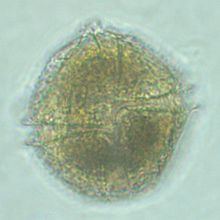Alge des Jahres
Die Alge des Jahres wird seit 2007 von der Sektion Phykologie in der Deutschen Botanischen Gesellschaft ernannt[1]. Gekürt werden Arten beziehungsweise Gattungen, die in ihrer ökologischen Bedeutung oder ihrer Bedrohung hervorhebenswert sind.
Algen des Jahres
| Jahr | deutscher Name | wissenschaftlicher Name | Abbildung |
|---|---|---|---|
| 2007 | – | Laminaria |  |
| 2008 | – | Micrasterias |  |
| 2009 | – | Gephyrocapsa huxleyi [Emiliania huxleyi] |  |
| 2010 | Froschlaichalgen | Batrachospermum |  |
| 2011 | – | Fragilariopsis cylindrus | |
| 2012 | Armleuchteralgen | Chara |  |
| 2013 | – | Lingulodinium polyedrum | |
| 2014 | – | Chlamydomonas reinhardtii |  |
| 2015 | Meersalat (Gattung) | Ulva |  |
| 2016 | Melosira arctica | ||
| 2017 | Blaugrüne Felskugel | Chroococcidiopsis (Gattung) |  |
| 2018 | – | Klebsormidium (Gattung) |  |
| 2019 | Blutschneealge | Chlamydomonas nivalis (revidiert: Sanguina nivaloides)[2] |  |
| 2020 | – | Chromera velia |  |
| 2021 | – | Vaucheria velutina |  |
| 2022 | – | Stylodinium |  |
| 2023 | – | Serritaenia | |
| 2024 | – | Sargassum |  |
| 2025 | – | Draparnaldia erecta |
Weblinks
- Alge des Jahres, Sektion Phykologie der Deutschen Botanischen Gesellschaft (DBG).
Einzelnachweise
- ↑ https://www.dbg-phykologie.de/alge-des-jahres
- ↑ Lenka Procházková, Thomas Leya, Heda Křížková, Linda Nedbalová: Sanguina nivaloides and Sanguina aurantia gen. et spp. nov. (Chlorophyta): the taxonomy, phylogeny, biogeography and ecology of two newly recognised algae causing red and orange snow. In: FEMS Microbiology Ecology. Band 95, Nr. 6, 1. Juni 2019, ISSN 1574-6941, S. fiz064, doi:10.1093/femsec/fiz064, PMID 31074825, PMC 6545352 (freier Volltext).
Auf dieser Seite verwendete Medien
Autor/Urheber: Mrmw, Lizenz: CC0
Karten-Icon für Navigationsleisten in Artikeln zu Deutschen Nationalparks u.ä.
Autor/Urheber: Alison R. Taylor (University of North Carolina Wilmington Microscopy Facility), Lizenz: CC BY 2.5
Emiliania huxleyi – single-celled marine phytoplankton that produce calcium carbonate scales (coccoliths). A scanning electron micrograph of a single coccolithophore cell.
Scanning electron microscope image, showing an example of green algae (Chlorophyta). Chlamydomanas reinhardtii is a unicellular flagellate used as a model system in molecular genetics work and flagellar motility studies.
Autor/Urheber: Corinna Romeikat, Lizenz: CC0
Stylodinium cf. bavariense (Phytodiniales, Dinophyceae)
Autor/Urheber: Sergey S. Dukachev, Lizenz: CC BY-SA 3.0
Small laminaria hyperborea
Autor/Urheber: Jitka Richtová, Lilach Sheiner, Ansgar Gruber, Shun-Min Yang, Luděk Koreny, Boris Striepen, Miroslav Oborník, Lizenz: CC BY 4.0
Intracellular distribution of heme biosynthesis in Chromera velia, inferred from in silico predictions.
- C. velia heme pathway enzymes: ALAS→ALAD1,2,3→PBGD→UROS→UROD1,2 3→CPOX1,2→PPOX1,2→FECH1,2
- No targeting signal identified: ALAS, ALAD2, UROS
Green algal cell (Chlamydomonas nivalis) responsible for red coloration of mountain snow packs. This organism utilizes pollutants carried in snow as a food source and reduces the acidity of meltwater. Thin section observed using TEM. Magnified 10,000X.
(TEM) Plate #.(c) Geographer in der Wikipedia auf Englisch, CC BY-SA 3.0
Ventral view of Lingulodinium polyedrum 900x magnification
Micrasterias under light microscope, order Desmidiales. Desmidiales are, most unicellular, green algae, comprising around 40 genera and 5,000 species, found mostly, but not exclusively, in fresh water. http://de.wikipedia.org/wiki/Zieralgen
Autor/Urheber: Lamiot, Lizenz: CC BY-SA 4.0
Sargassum (Sargassum muticum Yendo Fensholt 1955) photographed in situ in Wimereux shore (region of Hauts-de-France) in the bottom of the foreshore, July 16, 2016
Autor/Urheber: Katz Lab from Northampton, MA, USA, Lizenz: CC BY 2.0
Image courtesy of Dr. Tatiana Mikhailyuk, uploaded from Flickr, Katz lab photo stream
Autor/Urheber: T. Darienko, Lizenz: CC BY-SA 4.0
An international team of scientists has found that a strange type of bacteria can turn light into fuel in incredibly dim environments.
Similar bacteria could someday help humans colonize Mars and expand our search for life on other planets, researchers said in a statement released with the new work.
Organisms called cyanobacteria absorb sunlight to create energy, releasing oxygen in the process. But until now, researchers thought these bacteria could absorb only specific, higher-energy wavelengths of light. The new work reveals that at least one species of cyanobacteria, called Chroococcidiopsis thermalis — which lives in some of the world's most extreme environments — can absorb redder (less energetic) wavelengths of light, thus allowing it to thrive in dark conditions, such as deep underwater in hot springs. [Extreme Life on Earth: 8 Bizarre Creatures]
"This work redefines the minimum energy needed in light to drive photosynthesis," Jennifer Morton, a researcher at Australian National University (ANU) and a co-author of the new work, said in the statement. "This type of photosynthesis may well be happening in your garden, under a rock." (In fact, a related species has even been found living inside rocks in the desert.)
When grown in far-red light, this cyanobacteria, called Chroococcidiopsis thermalis, can still photosynthesize where others falter.
Credit: T. Darienko/CC BY-SA 4.0Autor/Urheber: Der ursprünglich hochladende Benutzer war Mike Krüger in der Wikipedia auf Deutsch, Lizenz: CC BY 3.0
Froschlaichalge
Autor/Urheber: Holger Krisp, Lizenz: CC BY 3.0
Meersalat, Ulva lactuca, Familie: Ulvaceae, Fundort: Kroatien, Istrien, Porec, Lanterna

















